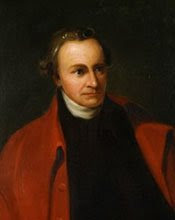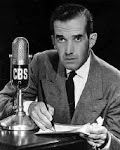A blindfold is ripped from a soldier's eyes. Looking up to get his bearings, he notes that he is in a forest. Looking down, he sees a long, deep pit, its floor carpeted with dead bodies in khaki uniform. He has moments left to live. He feels for his crucifix, but a bullet interrupts the conversation with his Maker. His lifeless corpse topples into the hole in the ground.
After him another man is shunted forward, the blindfold removed. The same ritual. Another bullet whistles through another brain. Then another. And another. The gruesome procedure is repeated until the hole fills with the bodies of hundreds and hundreds of innocent men.
This is the harrowing scene of a devastating new film, Katyn. It takes its name from the village in western Russia where the bodies of more than 4,000 Polish prisoners of war were dug up in 1943.
Gruesome: A scene from the new film shows a Russian solider shooting a Polish officer in the back of the head before another pushing his body into a mass grave
But these bodies were by no means the only ones to be disinterred. Near the Soviet city of Kalinin, now known as Tver, another 6,000 bodies were unearthed. Near Kharkov in Ukraine there were 4,000.
In all, more than 22,000 Poles - roughly two-thirds of them officers and policemen, the rest political prisoners - suffered the same appalling fate: to be executed, without trial or even warning, and thrown like carcasses into mass graves.
Their murderers were the NKVD, the Soviet secret police. Indeed, the chief executioner of the NKVD personally pulled the fatal trigger no fewer than 6,000 times in just 28 days.
The first genocide of World War II has become known as the Katyn Massacre. It took place in April 1940, 21 months before the Nazi regime devised the Final Solution at the Wannsee conference in January 1942.
The whole world knew that a large group of Polish officers had mysteriously disappeared soon after the Soviet annexation of eastern Poland on September 17, 1939.
The invasion came after the infamous Molotov-Ribbentrop pact which allowed Germany and the Soviet Union to carve up Poland between them. But the fate of the officers remained unknown until the bodies were discovered after the German invasion of the Soviet Union.
Even as the Nazis were liquidating Jews in the Warsaw ghetto, Goebbels's propaganda machine trumpeted the atrocity as evidence of Bolshevik brutality. Stalin counterinsisted that the mass murders had been committed by the Nazis.
Churchill knew the brutal truth, but it made sense to keep quiet. Stalin was our ally in the epic fight against Nazism, and his nose was not to be put out of joint. British silence remains one of the worst stains on our country's war record.
Even by the grisly standards of the 20th century, the Katyn Massacre was a crime of appalling enormity: a concerted attempt to wipe out an entire stratum of a great European nation. Behind the slaughter was a grisly piece of forward planning.
Stalin's long-term intention was for Poland to become a friendly neighbour under the Soviet sphere of influence. The fewer bourgeois enemies of Communism to oppose him, the better. So he started liquidating those Polish officers who, in long, punitive interrogations, could not be coaxed into taking a pro-Soviet stance.
The butchery of the cream of Polish manhood was characterised by a breathtaking lack of fuss. In the Katyn forest, the soldiers were frogmarched to deep, open pits. As his blindfold was removed, each officer would have seen the corpses mounting at his feet, and then heard the trigger.
In other locations - PoWs from camps at Starobilsk, near Kharkov, and Ostashkov, near Kalinin, the extermination took place indoors.
One by one, the officers were dragged to a prison cell, their hands tied behind them with wire, and then shot from behind. To drown out the noise, the cell door was lined with felt, and the drone of loud machines masked the incessant sound of gunshots-The bodies were unceremoniously lugged out through another door to a line of waiting trucks.
On that first night of killing, the NKVD butchers managed to dispatch 390 men. In subsequent days they confined the nightly tally to 250.
Devastating: Andrzej Wajda's movie dramatises the events of 1939 in Russia
The grim cargo was then driven to the site of the mass grave in the forest, and its contents dumped. It was a function of Soviet efficiency that, to make use of every cubic inch of space, the corpses were neatly stacked. (When the pits were exhumed, some were found to contain the bones of murdered Poles up to 12 deep. One pit had 1,200 corpses). Only one detail was unvarying: there were 22,000 holes in 22,000 Polish skulls.
Yet for some reason, the name of Katyn has never entered the global consciousness as other atrocities have.
Former Nazi concentration camp guard John Demjanjuk has just been extradited from the U.S. to Germany to stand trial as accessory to 29,000 deaths in the Holocaust. Bosnian Serb leader Radovan Karadzic awaits trial in The Hague for his part in the mass murder of 8,000 Bosnian Muslims at Srebrenica. But no one has ever stood in the dock for their part in the Katyn massacre.
The new film is the work of the great Polish director Andrzej Wajda, whose father, Jakub, was one of the murdered officers. As well as telling the story of their deaths, Katyn dramatises the aftermath of the war when, in communist Poland, it was forbidden to mention the dead officers.
For those who did, prison awaited. As a result, ignorance of the crime spread throughout Poland over 40 years. For decades, it fell to emigre Poles to keep the name of Katyn alive.
Among them are British Poles for whom Katyn remains a wound which refuses to heal. It's not just that their fathers were murdered - the officers' families also felt the blunt instrument of Soviet oppression. As part of Stalin's larger plan to weaken Polish opposition to Communism, 1.6 million Poles were deported to far-flung corners of the Soviet Union.
One of those British Poles is Andrzej Polniaszek. Now 81, he was 12 in 1939 when his father Franciszek, a doctor of law and an officer, was captured when the Soviets moved into Poland.
Soviet documentation has revealed that his father was taken to the camp in Starobelsk, where, over a long, bitterly cold winter, he would have been subjected to intense political agitation.
By March 5, when Stalin signed his execution order, he had been condemned to death as one of 22,000 'hardened and uncompromising enemies of Soviet authority'.
By April 13, Andrzej's father may well have been already dead. It was on that date that the young Andrzej, with his mother and sister, heard a knock on their apartment door.
'At three in the morning the soldiers came. We had an hour to pack only the things we could carry. They even warned: "Take warm clothes. You'll be there for some time." '
Meanwhile, in the Polish countryside, Waclaw and Janusz Gasiorowski, aged ten and seven, were rounded up with their mother and sister.
Their father Tadeusz, a lieutenant in the Pomeranian infantry, had been taken prisoner the previous September, and they feared the worst.
'There had been regular letters from our father,' recalls Janusz. 'And then it abruptly stopped. Not only our correspondence, but that of everyone who had someone in those camps.'
Andrzej Polniaszek ended up in Kazakhstan - 'a godforsaken part of the country with a Siberian climate'. When Waclaw and Janusz got off an overcrowded train carriage after 27 days, they were in Uzbekistan, 100 miles from the Chinese border.
Genocide: Polish officers await their fate in the new Katyn film which is out now
They were sent to live in stables spattered with manure, which was the only source of fuel. Waclaw still has the cheerful advice of a Soviet soldier ringing in his ears: 'Don't worry. You will get used to it. And if you don't get used to it, you will die.'
The boys were lucky. Their aunt was a dental surgeon whose skills were valuable. 'If she pulled out the tooth of a Russian, she got half a kilo of butter, a chicken or a bag of potatoes and this kept us going.'
Others were not so lucky. Of the 1.6 million Poles deported into far-flung outposts of the Soviet Union's gulag system, approximately a million died of cold, starvation and disease.
There was a seismic mood swing when news broke of the German invasion of the Soviet Union in June 1941. The Soviets suddenly needed their captive Poles, so they were freed to join a Polish army mustering under General Anders, who was released from the Lubyanka prison in Moscow, where he had been tortured, to fight with the Red Army.
For young Polish deportees, the only problem was how to join up. Railway carriages were clogged with wounded Soviet soldiers, permission to travel was hard to secure and distances were unimaginably vast.
Anders made things harder by taking the first wave of volunteers to Persia. Among them were the Gasiorowski boys, who travelled through Uzbekistan and Turkmenistan. On the way, Andrzej was separated from his mother and acknowledged that it had known all along who had been the true perpetrators of the Katyn Massacre.
Most, though not all of the graves in Ukraine, have since been exhumed. In 2000, Andrzej went to Kharkov to see the opening of the mass grave where his father was believed to have been buried. The bodies there had been buried in clay and failed to decompose.
To hide the atrocity, the NKVD returned to the grave with massive drilling devices and punched holes in the ground to aerate the grave and encourage decomposition. In the process, they destroyed the bodies.
'You can imagine how I felt when it was opened,' says Andrzej softly. 'The only way they could tell how many dead there were was by counting the skulls which had remained intact. Out of the 4,500 buried in Kharkov, we were only able to find 150 bodies. The rest was a mess.'
Andrzej has spent more than 60 years in his adoptive country. He married an Englishwoman and had three children who speak only pidgin Polish. He thinks he survived the hell of two Siberian winters because 'someone above decided that I could do something useful'.
Twenty years ago he founded the Association of Katyn Families Abroad, which has about 2,000 members. Now that the mood is changing towards the dark Soviet style of old in Putin's Russia, it becomes ever more certain that the murder of thousands of men such as Franciszek Polniaszek. Tadeusz Gasiorowski and, indeed, Jakub Wajda will go unpunished. So the task that remains is clear.
'One of the last things we have to do,' says Andrzej, 'is to keep the memory of what happened to our fathers for future generations. With my son and daughter I went back to Kharkov where my father was killed.
'In the cemetery there is a big bell half-submerged underground, so when it rings the sound goes into the ground where they are still buried. My son and I rang it and listened. And both of us cried.'
And as he recalls the knell clanging dolefully among Polish bones, Andrzej Polniaszek cries again.
KATYN is on release in selected cinemas.


















No comments:
Post a Comment